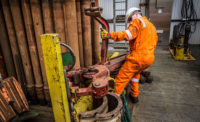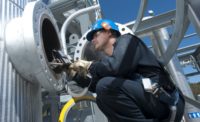Workers who are required to do their jobs in extremely hot environments — from construction sites to chemical plants and offshore oil rigs — can be at risk of serious heat-related injuries and illnesses. Selecting the proper personal protective equipment (PPE) for your employees is an important first step in helping to prevent such occurrences and a related work stoppage.
According to OSHA, any process or job site that is likely to raise workers’ deep core temperature (often listed as higher than 100.4˚F) raises the risk of heat stress.1 OSHA also states that thousands of workers become sick from occupational heat exposure each year, but that these cases are often preventable.2
Illnesses caused by heat stress can include heat stroke, when the body’s temperature regulation fails and body temperature rises to critical levels; heat exhaustion, resulting in fainting or heat collapse; and heat cramps from an electrolyte imbalance caused by sweating. It’s important to note that because these conditions can physically and mentally impair the worker, they can lead to slips, trips and falls, and equipment-related injuries that compound the situation.
Age, weight, degree of physical fitness and other factors contribute to heat stress, but the type of clothing your workers are required to wear, including footwear, is a key factor in ensuring their safety and comfort while on the job.
The foundation
Think of PPE as the foundation of your workers’ wellbeing, which could include a number of crucial items, such as footwear, flame-resistant garments, hard hats, eyewear, gloves and ear protection.
Below are five factors to consider when selecting a PPE provider for workers in high-heat environments as part of an overall heat-related illness and injury-prevention program.
1) Consider head-to-toe PPE solution needs.
When working with a PPE provider, it’s important to identify how the PPE will fit within your workers’ overall equipment needs. What environment do employees work in? Will the PPE need to stand up to harsh chemicals, extreme weather conditions or uneven terrain? What are the major issues and challenges that workers have to face each day?
A provider that offers a wide breadth of PPE solutions can make strategic recommendations that will work well with the other protective items required for your workers. Plus, partnering with an experienced provider who offers head-to-toe safety solutions will save you the time, money and energy you would have spent searching for individual products.
2) Ensure the safety solutions meet evolving standards.
Safety standards generally change every three to five years. If your company’s PPE is based on outdated standards, the compliance penalties fall solely on your company. Make sure your provider consistently updates their assortment with the latest certified and field-proven materials.
3) Consider workers’ comfort, too.
Even with proper training, workers who have to wear specialized PPE for long, grueling hours might avoid properly wearing items they consider uncomfortable, which can put them at risk. Many people have become accustomed to wearing sneakers and soft, breathable activewear materials in their free time, and they are starting to expect the same from their workplace safety solutions.
Ask your provider to show you what kinds of materials are used in the safety solutions they provide, and the level of comfort and protection those materials offer. With new advances in materials science, it’s possible to meet the demand for lighter and more comfortable equipment for the workplace, including safety footwear, without sacrificing protective capabilities.
For example, some of the newest protective and athletic-inspired footwear on the market features material with conductive fibers that actively move heat away from the skin and create an instant cooling sensation, but still meet prevailing industry safety standards.
4) Keep a solutions-first, products-second mindset.
If a PPE provider puts more of an emphasis on selling you products than your workers’ safety, you may not have the best fit for your company. A good partner should develop a strategic relationship with you, help you identify the biggest safety risks for your workers and provide ongoing solutions and education to mitigate those risks.
The best providers also simplify the entire purchasing process by offering a streamlined footwear and PPE management system, reducing the administrative work required of safety professionals and allowing you to focus on jobsite activities. Companies that invest in their employees’ safety should look for a PPE provider that offers a digital platform that makes it easy to manage every aspect of your company’s safety program, saving you additional time and energy.
5) Establish a heat illness prevention program.
Providing your workers with proper PPE is only one piece of the larger puzzle when it comes to ensuring their safety. If you haven’t done so already, now is the time to consider a risk assessment related to heat illness prevention.
Components of such a program can include providing employees and supervisors with training about the hazards of heat stress, specific symptoms and emergency situations to watch out for while on the job, and what to do if when a worker becomes ill, such as calling for immediate help and offering initial aid until medical help can arrive.3 Achieving workplace safety in hazardous environments should be a company-wide effort with top-to-bottom worker participation.
Sources
1. U.S. Department of Labor, Occupational Safety and Health Administration, Heat Stress Guide. https://www.osha.gov/SLTC/emergencypreparedness/guides/heat.html
2. U. S. Department of Labor, Occupational Safety and Health Administration, Occupational Heat Exposure Overview: Working in Outdoor and Indoor Heat Environments. https://www.osha.gov/SLTC/heatstress/
3. Occupational Safety and Health Administration, OSHA Quick Card, Protecting Workers from Heat Stress https://www.osha.gov/Publications/osha3154.pdf



